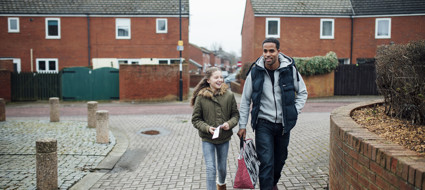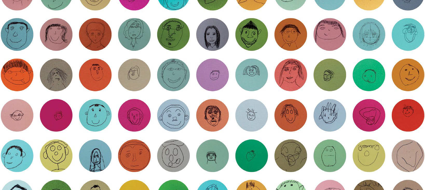How we can work with children, young people and families to make better use of data
Published:
Understanding how we can work alongside children, young people and families to develop approaches to information gathering and use.
Emma Smale, the convenor of the Children’s Information Project Learning Network talks with Dr. Liam Berriman, Prof. Elaine Sharland, Dr. Perpetua Kirby and Dr. Caitlin Shaughnessy from the University of Sussex about how we can work alongside children, young people and families to develop approaches to information gathering and use.
The Children’s Information Project Learning Network is funded by the Nuffield Strategic Fund and hosted by the University of Oxford in partnership with the University of Sussex, the London School of Economics and four Local Authority partners.
Talking points
This podcast looks at:
-
The growing amount of information and data that is being collected and how it is being used.
-
Considerations for ensuring that children and young people are stakeholders in their information.
-
Data literacy.
-
Integrating information practices with social care practices.
-
Hearing and recognising diverse voices.
[Introduction]
This is a Research in Practice podcast, supporting evidence informed practice with children and families, young people, and adults.
Emma: Welcome back to the Children's Information Project podcast. My name's Emma Smale, convenor of the Children's Information Project Learning Network. This project asks, 'Does better use of children's information lead to better lives for children, young people and families?' It seeks to learn from existing practice in Norwich through a two-way dialogue between the research taking place in four local areas, information use projects, and the experiences of practitioners, participation and co-production leads, information managers and data analysts, leaders, policymakers, and researchers. And of course from children, young people and families themselves. This podcast series is a chance to explore what the project is learning and to hear from one another about the challenges and opportunities we encounter. This is the second of two introductory podcasts for the project.
In the first episode, we heard about how data is shaped and influenced by people within local authorities, and that this impacts upon strategic decisions. If the voices of practitioners, of families and of children, are not always heard or listened to, then decisions are not framed or informed by their interests, aspirations or needs. There is a need to enable diverse voices to feel listened to and heard so that decisions are made in partnership with all children and families. And we reflected on making information meaningful so that our data systems can tell us about real experiences and provide a basis for doing things differently or better to improve children and families' lives.
[Voices about information and data]
Today, we consider people's opinions and feelings about data, principles for working with children and families' voices, and some practical ways in which to embed voice into the information used in children services. I'm delighted to be joined by Dr Liam Berriman and welcome back Professor Elaine Farmer, Dr Perpetua Kirby, and Dr Caitlin Shaughnessy from Sussex University. So today I'd like to start with something that I think is a really exciting part of the project, that it's focusing on voices about information and data and not just the voices expressed within them. Liam, I know this is a particular focus for you in the project. What kind of questions are you asking?
Liam: I think the starting point for this is that there's a really, kind of, growing amount of information that's being collected. Not just on children and families, but just generally in society. And that's becoming a growing issue, for actually how is that information being used and who has sight of it and how well it's being used. And, I think, from the perspective then of thinking about children's social care, I think, it's particularly the case then that we're thinking about what role can children and families play in having a voice about how their information's being used within those services, how can we help to think about what kinds of information are being collected? And to actually think with them about that big significant change that's happening, about the amount of information that's collected. But also how it's being used. And I think one of the big challenges is-, and this is what past researchers started to show us and it's a growing body of research in this area, is that there's a bit of a disconnection between where information is collected and used and the people who are featured within that information. And so that can potentially lead to potential distrust of how that information's being used, and it can also leave people unsure actually what information is collected and how people are actually using it.
So I think as a starting point it's starting to think about in what way we can integrate into part of this project questions about how we can think about young people and families, and children and families, as potentially being stakeholders of their information, of actually having some say in what's happening with their information.
[Ensuring that children and young people are stakeholders in their information]
Emma: I like that idea, that we're all stakeholders in our information. It reframes our relationship with information. So what needs to be considered if we view children and young people as stakeholders in their information?
Liam: So I think this involves, as we've kind of discussed already, being really careful that this is a process of consultation about their information that isn't just about lip service. So it's not just signing off to say, 'Okay, you can go ahead and use my information in this way,' and it shouldn't be tokenistic either, but actually thinking about what's a collaborative approach that we can take that builds trust around how information is used, whether that's in the form of data or not. But also thinking about different kinds of information and around changes in how that information's being used.
Emma: Do you mean with new technologies and digitally?
Liam: I'm thinking here particularly in a digital context. So as new kinds of practices around data linkage and around new forms of predictive modelling start to be used for certain kinds of information, how can we bring people into those conversations about those practices. How can we perhaps hear their concerns about what those practices might look like or how they might be used, or if they have concerns about them. So I think really importantly thinking about, you know, what's a collaborative approach to actually the design of information practices, what's a way in which voices from different stakeholders, including children and families but also practitioners and professionals, how can they feed into thinking about that.
I think another angle to this is recognising that, you know, information is a really important thing that's going to be collected. I think it's not to say that we're looking to say to people actually what should we not be doing, but rather actually feeding in their voices into those existing practices. Thinking about recognising that there is a wealth of information out there that is being collected already, and thinking about what is their existing awareness of this.
Emma: And I guess this links to how we relate to different types of information. A researcher might talk about qualitative information, for example, but a child or practitioner might call it something different.
Liam: They might regard it as being their record or their case file, and that might be a language they're more familiar with. But also perhaps delving into what their understanding is of some of the other forms of information that they might not be as aware of, so things like aggregated forms of administrative data.
[Making information transparent, equitable and ethical]
Moderator: Ok. So there are opportunities to think about a collaborative approach to designing information practices, as you say, and important questions about how we ensure that our approach and relationship to children's information is transparent, equitable and ethical. I'm sure we'll want to talk more about how to do this, but can you give us a brief example to get us thinking?
Liam: So we're designing these consultations then with a view to talking to children and families about their information, and one of the useful frames that we've got for thinking about that is about ideas of data literacy, which is essentially this idea that when we think about somebody's perspective on information or perspective on data it comes from a particular understanding. So the way that they understand how it's used, or the way that they understand what it means. So for example, for professionals, for practitioners, there are ways in which they will work with information as part of their practice, they'll have a sense as to how it's useful and in what forms they record information. And so we might think of that as being a form of data literacy. So how do we bridge that then with young people's everyday experience or with parents and carers, how do we talk about what are information and data in a way that's meaningful to them.
So it might mean, for example, looking for where there might be connections with their past experience. So, you know, data might mean to them the thing that's stored on their phone, it might mean something that relates to… I think particularly for young people in schools, the amount that they're told to be careful about their data footprint, is this idea that they understand that there's all this information that's collected on them but it primarily relates to their social media profiles, the things that they do on their phones. And it doesn't necessarily connect perhaps to their understanding of other forms of information that, as I said, already perhaps are not as visible to them, so things that are held by local authorities or by other parts of the public sector.
So data literacy then, about thinking about this idea of how do we connect different ideas about information. So as Elaine said earlier, again, that sense that there's not just one language for talking about this, that this project is very much about a more fluid understanding of data and information. As not necessarily meaning just one thing but recognising that it can be contextual, that there can be different understandings depending on whom we're talking to and in what context we're having that conversation.
So all of that kind of builds up to the sorts of questions we're asking then. So I think the questions we want to know are basically, you know, what does administrative information and data mean to people, where do they understand this language as being relevant to their lives, what do they conceive of as being information or data about them, and how do they think that's being used within their children's social care services and in their interactions with those services. Really importantly, what do they see as being ethical in the use of information, and recognising that what we think of as being ethical or what practitioners or professionals think of as being ethical, there may be some differences there. And so creating a venue in which recognising them as stakeholders is about bringing in their voices into a discussion about what's ethical. Really importantly, that this possibility that they might have a sense as to what isn't included in that information.
Emma: And we've talked about this in the first podcast, the idea that information that services and policymakers use doesn't accurately represent children and families' lives, there's a disconnect. It sounds like the project is delving into this gap, understanding diverse voices about data, as well as finding ways to better integrate multiple voices in the information that informs the way families are support, and the design of services and so on. Liam, finally I'd like to touch on some of the tensions that can rise when making space for multiple and diverse voices. There are likely to be differences of opinion, perspectives. And in the case of children and young people, how do we navigate our responsibilities to them as adults? It's not possible, desirable, or even safe to do what children and young people say they want or need.
Liam: When we're talking about information with young people and families, it's really important that when we bring their voices into this process that we don't over-promise. I think it's really important to recognise that there are going to be limits to what we can do in terms of potential changes to the way that information is used. But I think it's really important that we recognise that there are ways in which bringing their voices in is going to open up debate in new ways, potentially offering new opportunities to look at how information is used, to think about where we take information practices in the future. And I think that that's a fact of the way that we work with young people within this sector generally, is that we recognise that there are limits to what we can do, that there are ways in which issues around, for example, risk in safeguarding present particular challenges for the way in which we recognise what young people can say and have a say in in relation to the way that services are designed around them.
So I think it's recognising that those limits exists, ensuring that, again, as I said, that we don't over-promise in terms of what it is that we're saying we can do in consulting with them around this. But importantly, that this is a reality check for us and for others who are involved in thinking about information practices, that it's an opportunity for us to be challenged by young people and families who are likely to have different perspectives on how information is used, to have opportunities to perhaps not make assumptions about what they think and how they feel about their information. And to recognise generally these are very complex discussions that are going to involve potentially new ways of thinking but also ways in which we're going to have to think carefully about how we stage those conversations, so that we're bringing people together to have them but not necessarily, as I say, over-promising in what's possible.
Emma: Perpetua, would you like to come in here?
Perpetua: I just want to add that it's also about thinking about the role of the professional in listening to the voices of the young person. So, there's a reality check for us and what we might be able to promise, but similarly there is a pedagogic role, if you like, of the worker when listening to the voices of young people. So, it's certainly not about, you know, just doing whatever any young person wants. That would deny the responsibility and the role of the adult in that role of listening.
I think, part of the role is actually in supporting young people and children to think, well, what is it that they value, and what is their position, and what are their experiences. And to question what they desire as well, to challenge what they desire. 'Is that actually desirable for you, your family, the planet?' Or whatever it is they're asserting. Not to assert what it is they should think, but actually to get them to do the hard work of thinking for themselves and really thinking with the complexity of their lives. So not just a, sort of, quite a patronising, 'Oh, that's a lovely point. How interesting.' But actually a slightly more demanding role, a supportively demanding role. For them to have a bit of a reality check of the multiple factors in their life and what might be possible, and for them to have that time to work out. And then that becomes really meaningful, what they then say and the position they come to and the decisions they decide to make and the action they take. It's a much more considered, thoughtful process. And that can be the challenge of just a questionnaire tick box where they're not supported to really think through the complexity of their lives. So whilst that can be valuable, perhaps it's more valuable where they first have had that opportunity to think things through deeply with a professional that they trust.
Emma: I think this is a really important point that you're making here. And I'm hearing the importance of a dialogue, where actually there is autonomy for both parts of that conversation, whether it's the child, the young person, the parent, the professional. And actually that dialogue is something that we need to really be respecting and valuing in a slightly different way to perhaps it always is now. Elaine, you wanted to come in on that.
Elaine: Yes, as you were talking about that I was thinking, 'So how does this connect with information?' With information-related practices rather than the supportive and, as Perpetua put it, more pedagogic purpose of the interaction. But I think for us it's a good illustration about how social work practice and information practices are intertwined or can be really helpfully intertwined. So actually the need or the wish to record and to capture information that's meaningful is also a tool and a way to enable, let's say, a young person to really have a think about what they really do think and feel, and that process of doing that to be something that is also helpful for moving them forward or, you know, enhancing… so, it's a really nice example, I think, that illustrates the way that we see or want to see information practices really integrated with, say, social care practices, in ways that are recording things meaningfully, but also helping to change things.
[Integrating information practices with social care practices]
Emma: I think there's a theme that's coming across in terms of that integration, around it's not just contributing to information use, it's also changing practice. And actually, if we separate out children's information in its broadest sense with the practice around developing relationships with children and families too much, we actually get removed from the purpose of the conversations and the dialogue that we need and must have to really understand children and families' lives. And actually, that's why I'm really interested in examples and the, kind of, methodologies that you can share and, Caitlin, I think you were going to touch on some of those, because it's sometimes hard to get away from the abstract ideas and quite challenging to think about really concrete examples. So, how do I do this in my day-to-day practice?
Caitlin: Yes, so I think the emphasis really is on attendance to those, kind of, more perhaps observation or more non-verbal ways pertaining to voice, as well as the verbal and, as we've been saying, ensuring that there's that communication there about, when voices are expressed, or when voices are heard, how they might be acted upon or listened to. Because, as we've just been saying, if a voice is expressed that is contradictory or challenging in a way, how can a social worker communicate to ensure that that young person feels listened to or heard, but doesn't feel that it hasn't been acted upon, if it's particularly challenging? What we've seen, really, at an individual level, individual practice really ranges depending on who you're working with. So, for children in the early years, this might be looking much more closely at observation, at the interaction, the voice of the child, in terms of their play, in terms of how they're interacting with other children. And then as you move through, and for young people, it's actually maybe more about more creative methods such as emojis or voice notes, or postcards that are drawn, and have it interact with social workers that way. And we know that practitioners really are very skilled at listening to voice at an individual level, and it's just really about how we can design those systems to make these non-typical expressions of voice to come to be acted upon and documented in a better way within the systems.
Emma: What's really coming across is the actual enabling of information practice alongside the social work practice and actually maybe not separating these things out so much that it feels like an additional task or something that only can be put in a form. So, I think those examples are really helpful, thank you. So, with that in mind, there are of course important differences between social workers' experiences and researchers' experiences. Social workers may be good at listening to children's voices, of course, but they are listening to individual children and families about their lives and they're doing that in order to decide what support that child needs. So, it's very much located on that individual, while researchers are listening to lots of voices to gain a broader picture and understand different perspectives on this same question, perhaps. So, Elaine, I wonder if you could say a little bit more about how the Children's Information project will help local authorities and national policy makers recognise and hear diverse voices at the more, sort of, aggregate level, so not just the individual level, within and about children's information.
Elaine: Yes, thanks, Emma. And I think that really is… you know, it's a million-dollar question that we will be grappling with. And actually, as I've listened to the conversation through this podcast, that, if anything, is the question that's been, you know, preoccupying me most as we've gone through where we've got to to get to this point in the conversation. So actually, it's not just researchers, it's also, you know, anybody with a strategy hat on, anybody who is looking at aggregates, administrative data, is also looking at that biggest-picture stuff. But so much of what we've been talking about is about the nuance. It's about voice being relational, it's about it being not a thing that's readily, necessarily out there, you know, to be captured, noted down as ticked off in a survey etc. So, we've been talking, really, about how information and voice-related practices can be embedded to the good in social work practice on a, sort of, case level. How on earth do we try to move from that to something that Katelyn was describing, which is whole systems, something that is really about a different kind of integration of voice within and about data or about information throughout our information systems and use. So, I mean, just, sort of, recapping on that, I think it is a challenge, of course it's a challenge. We know, and it's fairly clear, the kind of information that appears at the moment in formal administrative data sets, particularly for national returns, but not just that, gives shortcomings in lots of ways, but also gives very little representation to voice, except perhaps tacitly, implicitly, the voices of policy makers. So, we know that. And at the other end of the spectrum, we also know that there is actually plenty of excellent voice-related… it may not be excellent enough and there's room… obviously, there's room, and we talked about a scope for enhancing this and amplifying this, but there is already, actually, excellent and richer material and some good, you know, material, information, that has emerged from voice-related practices that goes on at individual case level. But a lot of the information it does capture, where it is captured, where it certainly stays recorded at case level, and if it's acted upon, if it's acted upon, that's at case level.
We do need to recognise, I think, a lot of the conversation today has been about how voice is complex. It's nuanced, it's diverse, it's relationship, it's fluid. It is something that sometimes, you know, one can very helpfully capture or record, if you like, through surveys or through a consultation group. But by no means does that give us the nuance or the complexity that we've been talking about that tells us really what voice may more fundamentally be about.
Emma: Given all of this complexity, where's a good starting point?
Elaine: Probably a good starting point is to recognise that actually all children's administrative information, and that includes the information that makes its way into formal datasets, already does include voices, often, you know, the voices of those in senior management and government roles who decided what questions to ask… voices in, it's not impossible. In fact, it's intrinsic, in a way, that voice is built in. And that, really, what we are trying to do is find ways of shifting that balance of where and how voice does come into the information, whether it's administrative datasets or others, in shifting that balance further in the direction of the integration of children and young people's families' voices, and frontline professionals, so that they at least are represented and heard more loudly. So, if we don't conceptualise… think that this is something that, 'Oh my goodness, we've got to start from scratch,' actually recognising voice does get in there already, how can we actually amplify the particular voices that probably get in there are less well-represented and not so amplified? So, from there, really, what we are trying to do is look to see how we can support local authorities in developing those more nuanced, more diverse and, therefore, more meaningful ways of integrating those voices into and about children's information and listening to them. And that means, really, developing probably more and more multiple ways of considering and responding to individual voices and diverse voices, and that gives us, if you like, both a challenge and an opportunity now to work with partners to really try to identify how local authorities can plan to do this voice integration and information more systematically and more ethically.
Emma: So, if I may, I'm going to have a go at summarising. We need to expand the ways we elicit diverse voices and embed those voices in the information that gets recorded in children's services. At a systemic and aggregate level, it means improving information management systems, including mining the rich information that already exists, and it means developing measures which are informed and shaped by children and families' voices to better capture when things are really going well, or not, and to measure the things that matter to them and are actually meaningful for improving services and support. From there, we can scale up to a system level. And in all this, there need to be some core principles, ethics, ways of listening, hearing, acting on what has been voiced and what needs to be heard. Perpetua, let's finish with the principles that we should be considering.
Perpetua: If a voice is relational, what we mean by that is what is voiced or what it is possible to voice is always in a context of, and in relation to, others whom you're engaging with. But beyond that, also the context and the environment within which you're speaking. So, what we might say in this podcast here might be very different to what we might say if we're just talking privately to an individual worker whom we trust, you know, in a very different context. So, it's, the people, the context, the technologies that we're using here, enables us to do something different. So, we're really interested in looking at the context and the specific of that to think about, how do we enable children, young people and their families to voice, to speak, to communicate something that's important, that matters to them, and for others to be able to hear that as well? So, well, sort of, fundamentally, I suppose, that requires professionals who value the importance of listening and can convey that respectful attention to what children and their families are communicating. And that includes, sort of, close observation of the non-verbal as well as simply what is spoken, because it's not always possible to speak. And we may not even necessarily know what we want to speak, but we might communicate it through our bodies and non-verbally, so whether facial expressions or how we're sitting awkwardly, you know, in addition to what young people actually say and what they might write, for example, in a questionnaire. And in terms of that, sort of, respectful practice, it's often some of the smaller gestures that can convey that. It's that… the, sort of, 'How do we actively listen and how do we convey that?' So, you know, it is thinking very much about what those practices are and how do we support practitioners and young people to engage in meaningful dialogue, where they feel comfortable, and supported, too, to voice things. And when we're talking about listening to the non-verbal, that can also be… not simply the body language, but also, for example, non-attendance, non-shows, is a form of voice, particularly repeated non-shows. So, it's thinking more broadly about, what do we mean by voice? And what do we attend to, what might we think about?
Or a, sort of, playful non-engagement, when a child is sitting under the table rather than at the table as a means of voicing their experience of that engagement. So, we think about the place and the space as very much important, and the environment, when we're thinking about, how do we support this listening, and hearing of voices? So, it's also paying attention to formal opportunities, you know, form… well, like a questionnaire, for example, as a, or a consultation group, or a review, which is a more formal process, as well as the every day, informal interactions that-, and how do we set those up in a way that enable children and young people to communicate, whether that's the seating, the eye contact, with eye contact or lack of it? So, workers talk about, you know, doing very-, the mundane, everyday things, like making a cup of tea, or helping a young person to do something practical or driving them somewhere. And in those moments, it enables a different kind of conversation to happen. And so we're interested in the two. You know, how we can support these different sorts of engagements? And are later-or-earlier about enabling, not prescribing, in our approach to working with partners and, you know, I think that's our emphasis really as well in terms of working with young people. It's actually thinking about, well, what will enable this particular young person or this particular group of young people to voice something of importance to them? And so that draws our attention to the practices, but also the tools and resources that we use. So, there are quite familiar ones, like forms or questionnaires, and they can be really useful. But might we also think of different practices that enable them to engage in a different way and, also, that allow a bit more time, because for young people actually to, sort of, “tap in” what it is they experience and what it is they think, and to come to a position that they want to assert in relation to their lives, is difficult for all of us and it can be particularly difficult for children and young people in complex situations.
So, practices that might allow them a bit more time. For example, creative approaches, where they might draw or model and look at things from different perspectives. Or even technologies, like mobile phones, WhatsApp-ing, emojis, apps like Mind of my Own, that kind of thing.
Emma: Thank you, Perpetua. I think that leaves us with two really important thoughts, 1) that, actually, it's difficult to have a voice, particularly when there are lots of things going on in one's life and particularly for some the children and young people that children's services work with and seek to support. And therefore, it's so very important to think creatively and with curiosity about how to ensure that children and young people can be comfortable about having a voice, to have enough space and enough time to say what they think. Thank you very much to all of my guests today, it's been an absolute pleasure. We've covered a huge amount. For more information about the Children's Information project, there is information alongside this podcast. And watch out for more episodes coming soon. Thank you.
[Outro]
Thanks for listening to this Research in Practice podcast. We hope you've enjoyed it. Why not share with your colleagues and let us know your thoughts on X (formerly Twitter) @researchIP and LinkedIn.
Reflective questions
Here are reflective questions to stimulate conversation and support practice.
-
How can you build trust with children and young people around how you are making use of their information?
-
What would a collaborative approach to designing information practices look like in your work?
Resources that are mentioned in this podcast
Further Research in Practice resources are available below, see Related Content.
Professional Standards
PQS:KSS - Relationships and effective direct work | Communication | Confident analysis and decision-making | Designing a system to support effective practice | Creating a context for excellent practice
PCF - Knowledge







